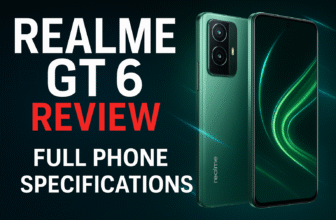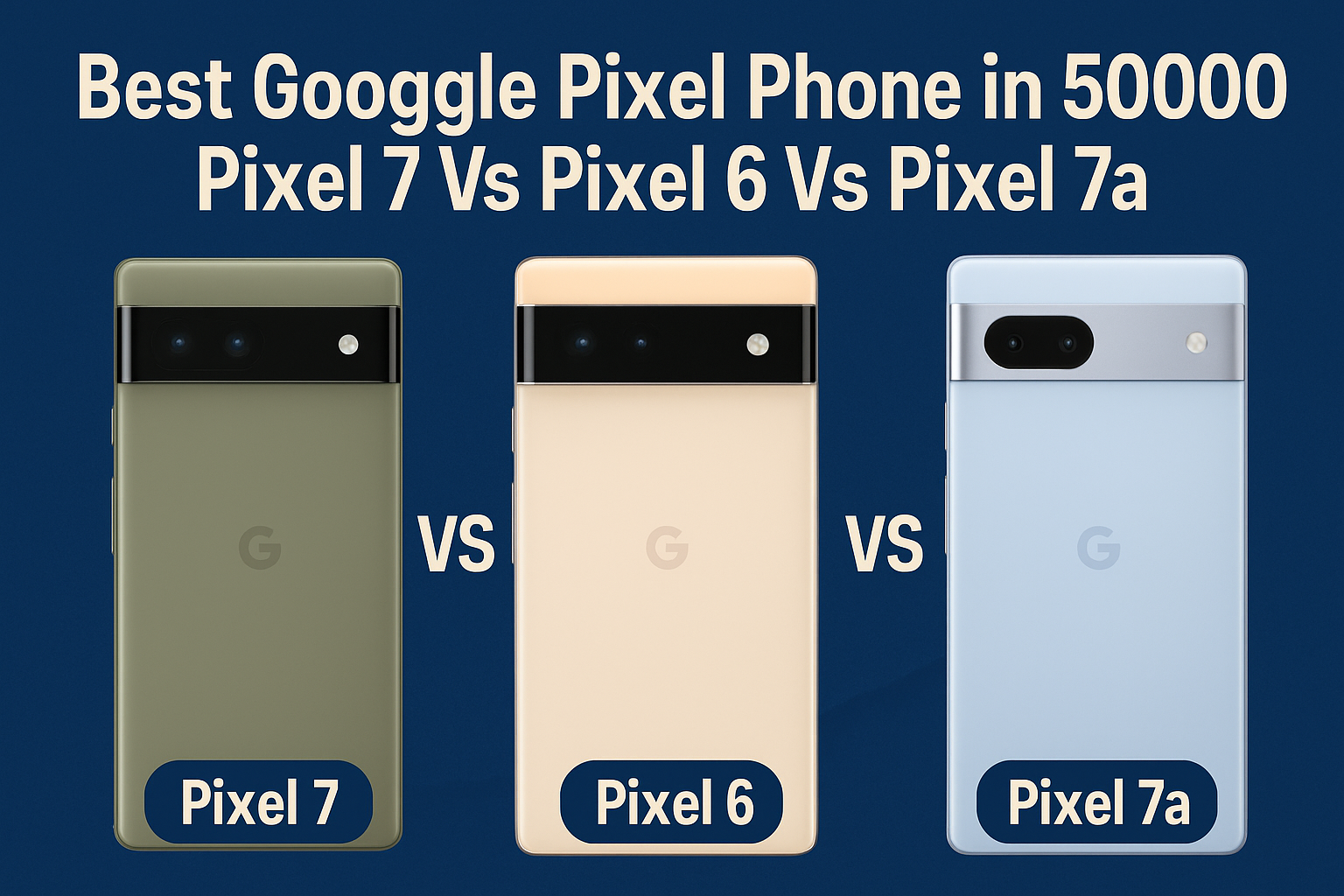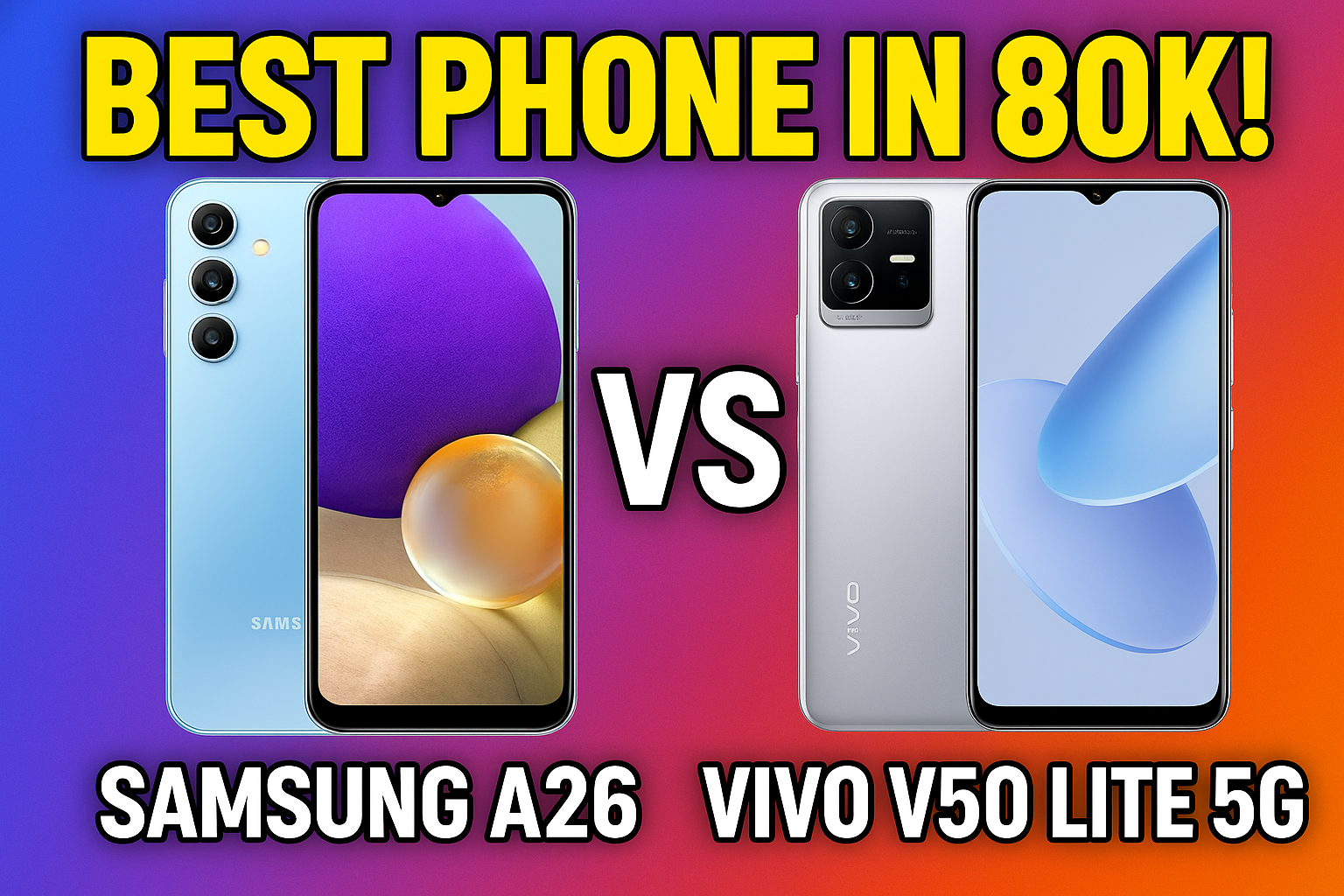
In the competitive mid-range smartphone segment, finding the right phone that balances performance, design, camera, and battery life can be challenging. Today, we dive deep into a detailed comparison of two popular contenders in the 80,000 to 90,000 price range: Samsung Galaxy A26 and Vivo V50 Lite 5G. This guide will help you decide which phone suits your needs better, whether it’s for photography, gaming, or everyday use.
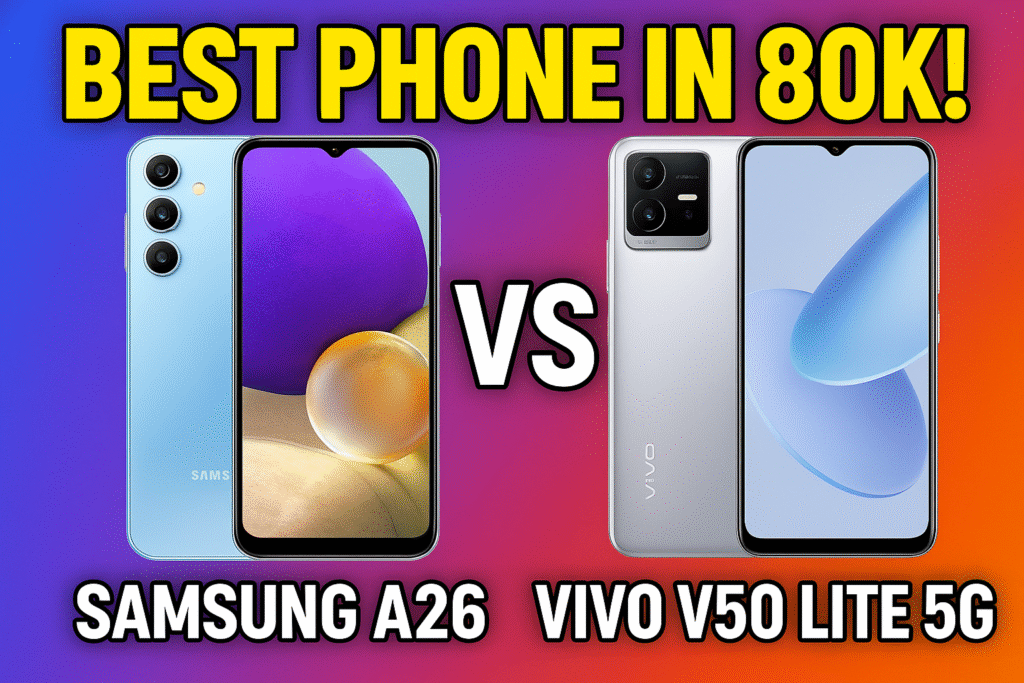
Price and Availability
Both phones fall into a similar price bracket after discounts, typically ranging between 80,000 and 82,000 in the offline market. The Samsung A26 retails around 85,000 with fewer discounts, while the Vivo V50 Lite has a retail price near 90,000 but usually offers better discounts. So, financially, both phones are quite competitive, making the choice depend more on features and performance.
Build Quality and Design
When it comes to design, the two phones follow different philosophies, catering to diverse preferences:
- Samsung A26: Features a slightly wider profile compared to its predecessors with a premium touch thanks to Gorilla Glass Victus 826 on the back and a matte finish that blends plastic and glass elements. It also boasts an IP67 rating, offering better water and dust resistance.
- Vivo V50 Lite 5G: Offers a more compact and glossy design with Gorilla Glass VTS Plus protection. It has a slightly thicker body (7.79 mm) compared to the A26 (7.7 mm) but is lighter at 197 grams versus Samsung’s 200 grams. Vivo’s design leans more towards an appealing camera layout and sleek aesthetics.
While Samsung provides better durability with its IP67 rating and matte finish, Vivo wins in terms of visual appeal and compactness.
Display Quality and Experience
Display is one of the standout aspects where these two phones differ:
- Vivo V50 Lite 5G: Offers a 6.77-inch AMOLED display with over 90% screen-to-body ratio, thin bezels, and a punch-hole camera cutout. It supports Always-On Display and features an in-display fingerprint sensor. The peak brightness can reach between 1300 to 1800 nits, making it brighter in daylight and better for viewing angles.
- Samsung A26: Comes with a slightly smaller 6.7-inch AMOLED display but with a noticeable notch and chin, lacking an in-display fingerprint sensor. It has Gorilla Glass VTS Plus protection and a peak brightness of about 1200 nits. Samsung supports HDR playback on YouTube at 2160p, while Vivo maxes out at 1440p without HDR.
Overall, Vivo’s display offers a more immersive and modern experience thanks to its higher brightness, minimal bezels, and additional features like Always-On Display and in-display fingerprint sensor. Samsung’s display, however, provides better scratch resistance and HDR support on YouTube.
Performance and Software
Under the hood, both phones pack capable 5G chipsets but with some differences:
- Samsung A26: Powered by the Exynos 1380 chipset (5nm) clocked at 2.4 GHz. It comes with 8GB RAM and 256GB storage featuring LPDDR4X and UFS 2.2. Samsung promises up to 6 years of Android updates, starting with Android 15 and One UI 7, making it highly future-proof.
- Vivo V50 Lite 5G: Runs on the MediaTek Dimensity 6300 (6nm) also clocked at 2.4 GHz, with a higher 12GB RAM and 256GB storage. It uses FunTouch OS 15 on Android 15 but offers only 3 years of software updates.
In benchmarks and real-world testing, Samsung shows better CPU stability and GPU performance, completing video rendering and benchmark tasks faster and smoother. Vivo, despite the higher RAM, struggles a bit with sustained performance and gaming, capping frame rates at 40fps compared to Samsung’s 60fps support.
AI Features and Daily Use
Both smartphones come with AI tools such as Google Gemini, AI Eraser, Object Eraser, and Circle to Search, enhancing everyday utility. However, Samsung’s One UI interface feels more polished with larger icons and better sustained performance, making daily use more fluid.
Gaming Experience
For mobile gamers, Samsung A26 offers a clear advantage:
- Supports stable 60fps gameplay with improved GPU performance.
- Better thermal management and connectivity for an uninterrupted experience.
Vivo V50 Lite 5G supports up to 40fps and doesn’t maintain sustained gaming performance as well, making it less ideal for heavy gamers.
Sound Quality
Vivo takes the lead here with dual stereo speakers, delivering a richer and more immersive audio experience. Samsung A26 only has a single speaker, which is a downside for media consumption enthusiasts.
Battery and Charging
Battery life is another area where these phones differ significantly:
- Vivo V50 Lite 5G: Equipped with a massive 6500mAh battery and supports blazing-fast 90W charging. However, it takes about 1 hour and 15 minutes to fully charge due to the large capacity.
- Samsung A26: Comes with a 5000mAh battery and 25W fast charging, but the charger is sold separately for around 4500.
Vivo clearly offers longer battery life with quicker charging out of the box, making it a better choice for heavy usage and travelers.
Connectivity Features
Both phones support the latest connectivity options:
- Bluetooth 5.4 on Vivo vs 5.3 on Samsung.
- Wi-Fi 6 on Vivo compared to Wi-Fi 5 on Samsung.
- Both support NFC.
- Vivo’s in-display fingerprint sensor is side-mounted, while Samsung lacks an in-display fingerprint sensor.
Camera Performance
Camera quality often drives buying decisions, so here’s an in-depth look:
Front Camera
- Vivo V50 Lite 5G: Packs a 32MP front camera but tends to wash out colors and struggles with stabilization, especially in indoor lighting.
- Samsung A26: Has a 13MP front camera that delivers more natural colors, better skin tones, and superior video stability at 1080p 30fps.
For selfies and video calls, Samsung A26 is the clear winner despite the lower megapixel count.
Rear Camera
- Both phones feature a 50MP main sensor and an 8MP ultra-wide lens.
- Samsung includes a 2MP macro sensor and optical image stabilization (OIS), absent in Vivo.
- Samsung supports 4K video recording at 30fps, while Vivo maxes out at 1080p 60fps.
Samsung’s camera produces more balanced colors, better dynamic range, and stable videos even without stabilization mode enabled. Vivo’s rear camera offers boosted colors and decent close-up shots but struggles with skin tones and dynamic range, often washing out greens and human subjects.
In portrait mode, Vivo offers dual focal lengths (23mm and 51mm), but Samsung’s portraits maintain more natural skin tones and overall better quality.
Final Verdict: Which One Should You Choose?
Both phones have their strengths and weaknesses, so your choice depends on your priorities:
- Choose Vivo V50 Lite 5G if: You want a compact design, a larger battery with ultra-fast charging, a better display with minimal bezels, and dual stereo speakers.
- Choose Samsung Galaxy A26 if: You prioritize better sustained performance, superior camera quality (both front and rear), longer software support (6 years of Android updates), and more durable build with IP67 rating.
If display and battery life are your top priorities, Vivo V50 Lite 5G stands out. However, for performance, camera, and software longevity, Samsung Galaxy A26 offers a more balanced and future-proof experience despite some compromises like the notch display and lack of in-display fingerprint sensor.
Ultimately, both phones offer solid value for money in the mid-range segment, and your personal preference for design, camera performance, and software experience will guide your decision.
Let us know in the comments which phone you would pick and why. Hopefully, this detailed comparison helps you make an informed choice in 2025!
Here’s both mobiles specs and company price:
Samsung A26 5G
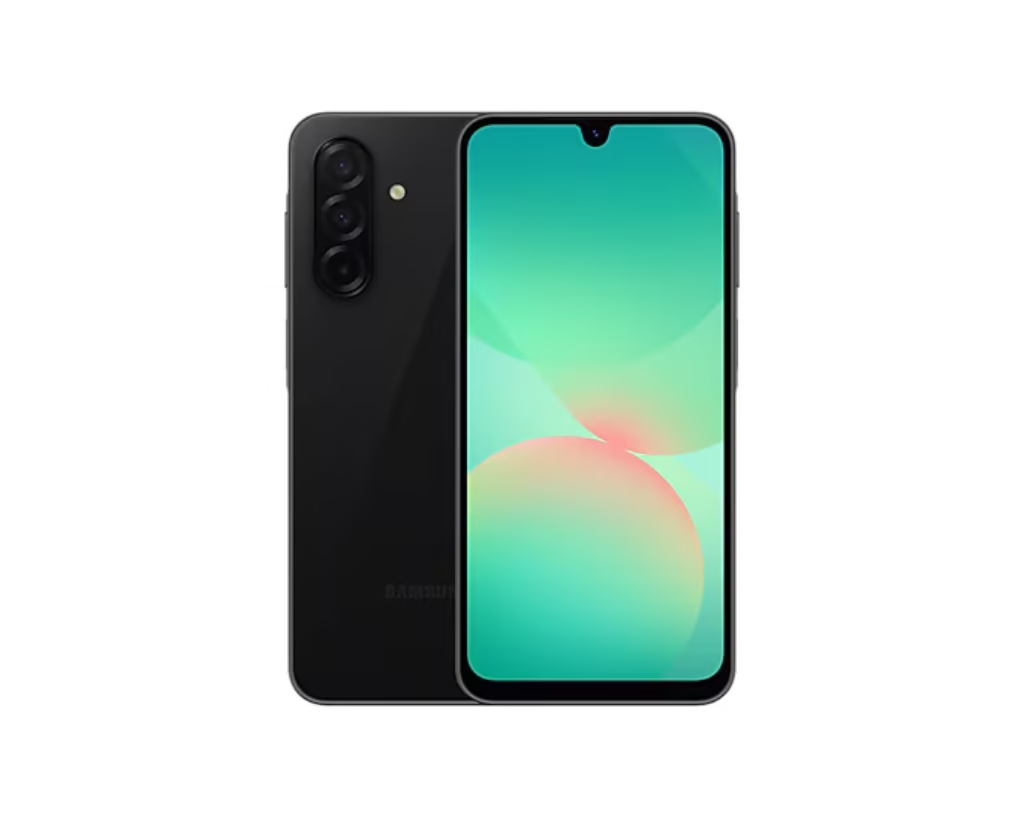
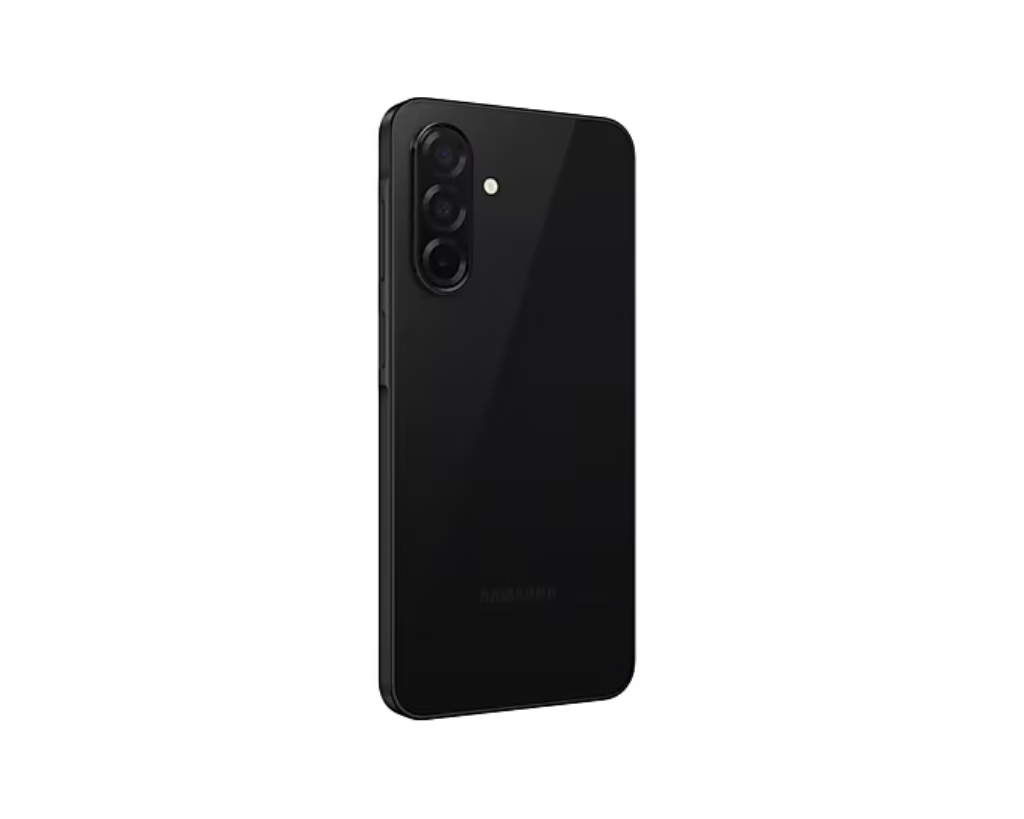
Samsung A26 5G Price And Specifications
Galaxy A26 5G Price
Rs. 84,999.00
Samsung A26 5G Specifications
Overview
| Weight (g) 200 | CPU Speed 2.4GHz, 2GHz |
Processor
| CPU Speed 2.4GHz, 2GHz | CPU Type Octa-Core |
Display
| Size (Main_Display) 169.1mm (6.7″) | Resolution (Main Display) 1080 x 2340 (FHD+) | Technology (Main Display) Super AMOLED | Color Depth (Main Display) 16M |
| Max Refresh Rate (Main Display) 120 Hz |
Camera
| Rear Camera – Resolution (Multiple) 50.0 MP + 8.0 MP + 2.0 MP | Rear Camera – F Number (Multiple) F1.8 , F2.2 , F2.4 | Rear Camera – Auto Focus Yes | Rear Camera – OIS Yes |
| Rear Camera Zoom Digital Zoom up to 10x | Front Camera – Resolution 13.0 MP | Front Camera – F Number F2.2 | Front Camera – Auto Focus No |
| Front Camera – OIS No | Rear Camera – Flash Yes | Front Camera – Flash No | Video Recording Resolution UHD 4K (3840 x 2160) @30fps |
| Slow Motion 480fps @HD, 240fps @HD |
Storage/Memory
| Memory_(GB) 8 | Storage (GB) 256 | Available Storage (GB) 234.3 | External Storage Support MicroSD (Up to 2TB) |
Network/Bearer
| Number of SIM Dual-SIM | SIM size Nano-SIM (4FF) | SIM Slot Type SIM 1 + Hybrid (SIM or MicroSD) | Infra 2G GSM, 3G WCDMA, 4G LTE FDD, 4G LTE TDD, 5G Sub6 FDD, 5G Sub6 TDD |
| 2G GSM GSM850, GSM900, DCS1800, PCS1900 | 3G UMTS B1(2100), B2(1900), B4(AWS), B5(850), B8(900) | 4G FDD LTE B1(2100), B2(1900), B3(1800), B4(AWS), B5(850), B7(2600), B8(900), B12(700), B17(700), B20(800), B26(850), B28(700), B66(AWS-3) | 4G TDD LTE B38(2600), B40(2300), B41(2500) |
| 5G FDD Sub6 N1(2100), N3(1800), N5(850), N7(2600), N8(900), N20(800), N28(700), N66(AWS-3), N71(600) | 5G TDD Sub6 N38(2600), N40(2300), N41(2500), N77(3700), N78(3500) |
Connectivity
| USB Interface USB Type-C | USB Version USB 2.0 | Location Technology GPS, Glonass, Beidou, Galileo, QZSS | Earjack USB Type-C |
| MHL No | Wi-Fi 802.11a/b/g/n/ac 2.4GHz+5GHz, VHT80 | Wi-Fi Direct Yes | Bluetooth Version Bluetooth v5.3 |
| PC Sync. Smart Switch (PC version) |
OS
| Android |
General Information
| Form Factor Touch Bar |
Sensors
| Accelerometer, Fingerprint Sensor, Gyro Sensor, Geomagnetic Sensor, Light Sensor, Virtual Proximity Sensing |
Physical specification
| Dimension (HxWxD, mm) 164.0 x 77.5 x 7.7 | Weight (g) 200 |
Battery
| Battery Capacity (mAh, Typical) 5000 | Removable No |
Audio and Video
| Stereo Support No | Video Playing Format MP4, M4V, 3GP, 3G2, AVI, FLV, MKV, WEBM | Video Playing Resolution UHD 4K (3840 x 2160) @30fps | Audio Playing Format MP3, M4A, 3GA, AAC, OGG, OGA, WAV, AMR, AWB, FLAC, MID, MIDI, XMF, MXMF, IMY, RTTTL, RTX, OTA |
Services and Applications
| Gear Support Galaxy Ring, Galaxy Buds3 Pro, Galaxy Buds2 Pro, Galaxy Buds Pro, Galaxy Buds Live, Galaxy Buds+, Galaxy Buds3, Galaxy Buds2, Galaxy Buds, Galaxy Buds FE, Galaxy Fit3, Galaxy Fit2, Galaxy Fit e, Galaxy Fit, Galaxy Watch FE, Galaxy Watch Ultra, Galaxy Watch7, Galaxy Watch6, Galaxy Watch5, Galaxy Watch4, Galaxy Watch3, Galaxy Watch, Galaxy Watch Active2, Galaxy Watch Active | Samsung DeX Support No | Bluetooth® Hearing Aid Support Android Audio Streaming for Hearing Aid(ASHA) | SmartThings Support Yes |
| Mobile TV No |
Software Support
- Security Update Period (Valid until)31 March 2031
Vivo V50 Lite 5 G
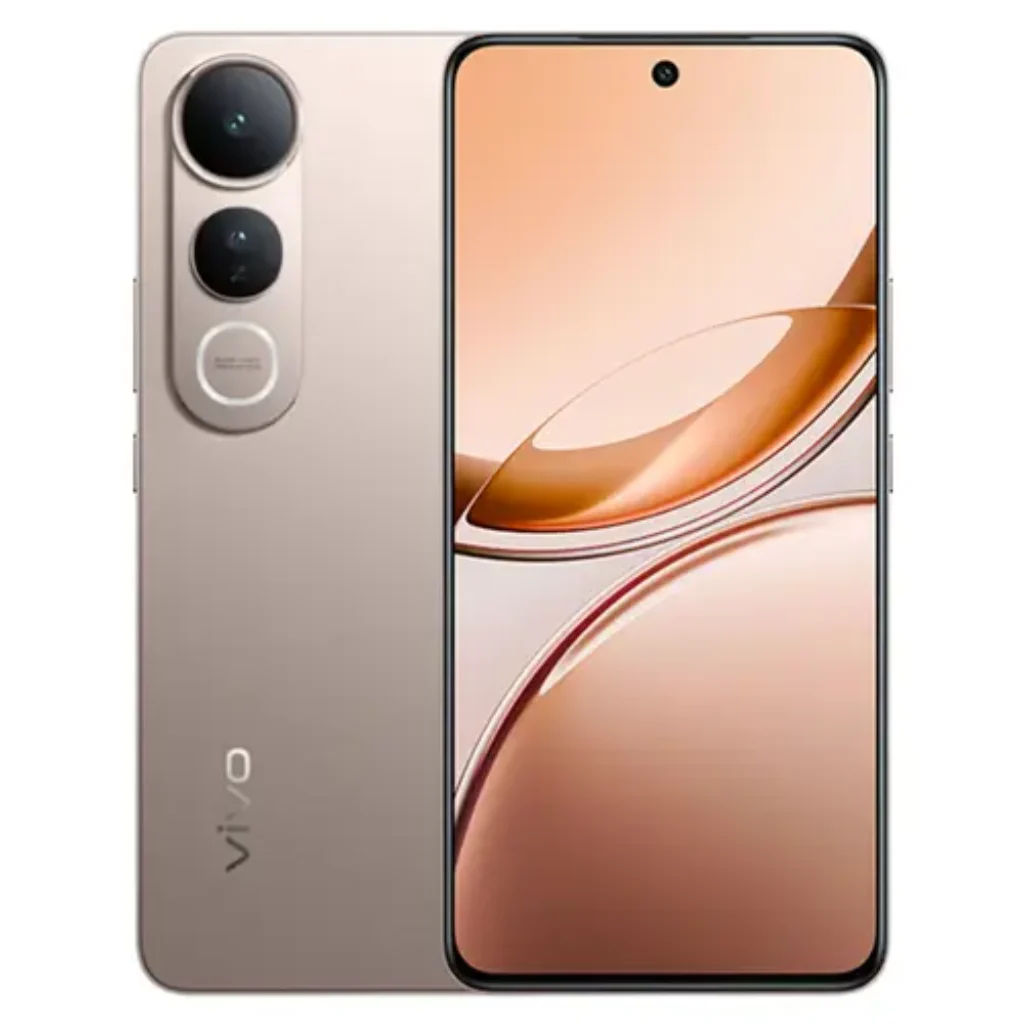
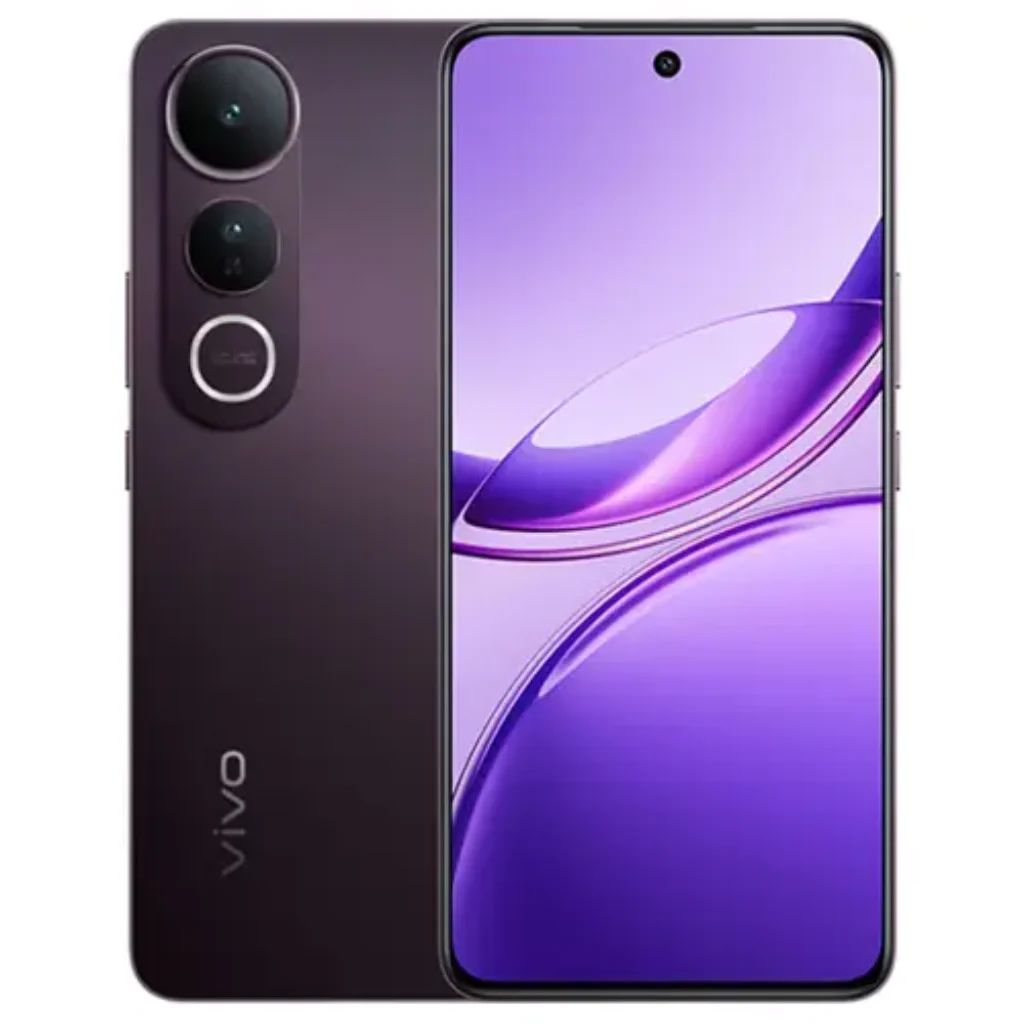
Vivo V50 Lite 5 G Price and Specifications
Vivo V50 Lite 5 G Price
Rs. 89,999
Vivo V50 Lite 5 G Specifications
Basic
| Ingress Protection Rating | IP65 |
| Operating System | Funtouch OS 15 |
| Android Version | Android 15 |
Platform
| Processor | MediaTek Dimensity 6300 |
| CPU Core Count | 8 |
| Process Node | 6 nm |
| CPU Clock Speed | 2 × 2.4 GHz + 6 × 2.0 GHz |
Storage
| RAM & ROM | 12 GB + 256 GB |
| RAM Type | LPDDR4X |
| ROM Type | UFS 2.2 |
| Expandable RAM Capacity | 12 GB |
| Expandable ROM Capacity | / |
Battery
| Battery | Typical capacity: 6500 mAh (3.91V) |
| Charging Power | 90W |
| Battery Type | Li-ion battery |
Design
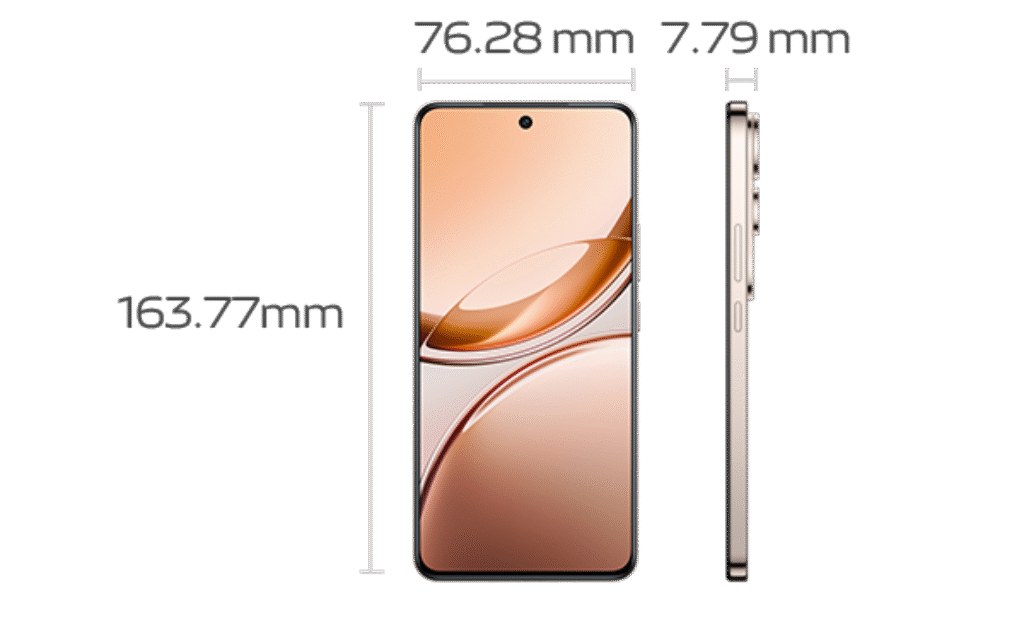
| Dimensions | 163.77mm × 76.28mm × 7.79mm |
| Weight | 197g |
| Back Cover Material | Plastic composite sheet |
| Fingerprint Sensor Type | In-display optical fingerprint sensor |
Display
| Size | 6.77″ (17.20 cm) |
| Resolution | 2392 × 1080 |
| Refresh Rate | 60 Hz/90 Hz/120 Hz |
| Local Peak Brightness | 1800 nits |
| Color Gamut | P3 |
| Color Saturation | 105% |
| Pixel Density | 387 PPI |
| Light-Emitting Material | U8 |
| Type | AMOLED |
| Touch Screen | Capacitive multi-touch |
Network
| 2G GSM | 850/900/1800/1900 MHz |
| 3G WCDMA | B1/B2/B4/B5/B8 |
| 4G FDD-LTE | B1/B2/B3/B4/B5/B7/B8/B19/B20/B28 |
| 4G TD-LTE | B38/B39/B40/B41 |
| 5G | n1/n3/n5/n7/n8/n20/n28/n38/n40/n41/n77/n78 |
| Card Slot | 2 nano SIMs |
| Standby Mode | 5G + 5G Dual SIM Dual Standby |
Camera
| Camera | Front 32 MP, Rear 50 MP (Sony IMX882) + 8 MP |
| Aperture | Front f/2.45, Rear f/1.79 + f/2.2 |
| Flash | Rear flash, Aura Light |
| Scene Mode | Front camera: Night, Portrait, Photo, Video, Dual View, Live PhotoRear camera: Night, Portrait, Photo, Video, 50 MP, Pano, Documents, Slo-mo, Time-lapse, Supermoon, Pro, Dual View, Live Photo |
Media
| Hi-Fi | Not supported |
| Audio Playback | AAC, WAV, MP3, MIDI, VORBIS, APE, FLAC |
| Video Playback | MP4; 3GP; AVI; FLV; MKV; WEBM; TS; ASF |
| Video Recording | MP4 |
| Voice Recording | Supported |
Connectivity
| Wi-Fi | 2.4 GHz, 5 GHz |
| Bluetooth | 5.4 |
| USB | Type-C |
| GPS | Supported |
| OTG | Supported |
| NFC | Supported (Egypt/Kazakhstan/Kenya)Not supported (Pakistan/Nepal/Bhutan) |
| FM | Not supported |
Location
GPS, BeiDou, GLONASS, Galileo, QZSS
Sensors
| Accelerometer | Supported |
| Ambient Light Sensor | Supported |
| E-compass | Supported |
| Proximity Sensor | Supported |
| Color Temperature Sensor | Not supported |
| Motor | Supported |
| Gyroscope | Supported |
| Others | Not supported |
In the Box
| Model | V50 Lite 5G |
| Quick Start Guide | Supported |
| USB Cable | Supported |
| Charger | Supported |
| Eject Tool | Supported |
| Phone Case | Supported |
| Protective Film (applied) | Supported |
| Warranty Card | Supported |
1. Actual network functionality is subject to carrier network availability, applicable laws and regulations, infrastructure support, and software version of the mobile phone. 2. Actual available RAM is less than 12 GB due to the storage of operating system and pre-installed apps. Actual available ROM is less than 256 GB due to the storage of operating system and pre-installed apps. 3. Actual charging power is dynamically adjusted as the battery level changes and subject to actual usage. 4.Actual dimensions may differ due to variations in processes, measurement method, and material supplies. Actual weight may differ due to variations in processes, measurement method, and material supplies. 5. Measured diagonally, the screen size is 17.20 cm (6.77 inches) in the full rectangle. Actual display area is slightly smaller. 6. Pixel value may vary in different camera modes and is subject to actual usage.


